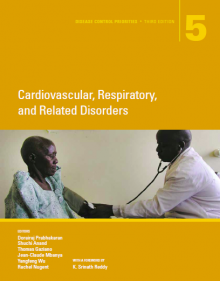
Copyright: Julia Manzerova
Foreword by Dr. K. Srinath Reddy

As the world sets its sights on the avidly aspirational Sustainable Development Goals (SDGs) of 2030, the health goal to secure healthy lives for all and well-being at all ages is especially ambitious. The global health agenda of the Millennium Development Goals (MDGs) has been expanded in the SDGs to include noncommunicable diseases (NCDs)—the greatest public health threat of this century. Concerted action on many areas of health has now been positioned on the platform of universal health coverage (UHC) to ensure equitable and effective provision of essential health services.
In this context, cardiovascular diseases (CVDs) collectively pose the greatest challenge as well as the greatest opportunity to health systems across the world. The challenge arises from the fact that CVDs are the largest overall contributor to global mortality, as well as a major cause of premature mortality below the age of 70 years. The Indian experience, with which I am most familiar, has shown how the escalating epidemics of CVDs and other NCDs not only impose a high cost of healthy life-years lost; they also lead to unaffordable financial burdens on both families and health systems.
With coronary heart disease and stroke as the major manifestations, CVDs present a serious threat to health and development across the world. Low- and middleincome countries (LMICs) now not only join highincome countries (HICs) in suffering high proportional mortality from CVDs; these conditions also account for far higher absolute and premature mortality tolls of CVDs. Rising burdens of renal disease share major risk factors, especially high blood pressure and diabetes, with CVDs. Similarly, respiratory diseases share tobacco as a major risk factor for CVDs. Renal and respiratory diseases join CVDs in posing challenges of preventing, as well as providing appropriate acute and chronic care to health systems everywhere.
However, CVDs also offer a major opportunity to all countries—especially LMICs—to reduce the high burden of disease by averting premature mortality and reducing morbidity through interventions that have proven to be highly effective in preventing disease and death in the prime of productive mid-life. These range from policy instruments, like higher taxes on tobacco products, to health service improvements that expand and intensify the coverage of effective secondary prevention to persons who have survived a cardiovascular event but remain at risk of recurrence. Among the major NCDs, CVDs have the largest array of proven interventions that have demonstrated the benefit of substantial reductions in mortality and morbidity. If the goal of reducing premature mortality from NCDs by one-third between 2015 and 2030 is to be attained, the largest contribution has to come from interventions directed at CVDs, since such a high magnitude of benefit is presently demonstrated only for these interventions in the NCD spectrum.
When positioned in the context of UHC, interventions not only need to demonstrate efficacy but also cost- effectiveness and affordability for accommodation in national budgets—especially in the resource- constrained health systems of LMICs. Hence, economic evaluation has to complement biomedical, epidemiological, clinical, and health systems research to identify high-impact interventions that provide best value for money. This is particularly imperative in an environment of rapid technological advancement, when the seductive appeal of high-profile technologies can misdirect priorities in resource allocation. Unless guided by evidence-informed policy, affairs of the heart can be very costly in more than a poetic sense! Renal and respiratory diseases, too, require prioritization of resource-optimizing health interventions.
The Disease Control Priorities project (DCP), in its two previous editions, provided the best contemporaneous analysis of major global health challenges and offered policy-enabling cost- effectiveness estimates of interventions that were available to address them. DCP3 continues that tradition by presenting the best available evidence on cost-effective interventions that will substantially impact and improve global health if earnestly implemented. The reasoned recommendations bridge the often-disconnected realms of rigorous scientific research and real-world policy relevance. Responses to NCDs, long neglected by health systems in LMICs, need to use such evidence to identify prioritized pathways of action and develop efficient delivery systems for the services selected to minimize the health costs of missed or messed opportunities.
This volume on CVDs, renal, and respiratory disorders has particularly high value. It carries the potential to become the most effective game-changer in global health by helping all countries to combat, contain, and control the biggest killer presently prowling the globe and by enabling us to reach the 2030 goals for NCDs and health overall. As one who has witnessed the epidemic of CVDs advance menacingly across the world in the past four decades, I fervently hope that the clear and convincing messages conveyed by the extensively researched and elegantly communicated analyses in this volume will be heard, heeded, and harmonized with policy and practice in all countries. In that hope, this Foreword looks to action moving fast forward.
K. Srinath Reddy
President, Public Health Foundation of India
New Delhi, India

